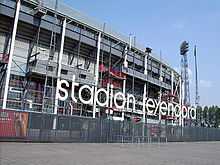Johannes Brinkman



Johannes Andreas Brinkman[1] (22 March 1902 – 6 May 1949), also known as Jan Brinkman,[2] was a Dutch architect and exponent of Nieuwe Bouwen, modern architecture in the Netherlands.
Biography
Brinkman was born in Rotterdam, Netherlands, in 1902.[3] He was the son of architect Michiel Brinkman (1873–1925), who established a firm in Rotterdam in 1910 and was known for designing the Spangen neighborhood of Rotterdam in 1922. Johannes studied civil engineering at the Delft University of Technology (Dutch: Technische Universiteit Delft). After Michiel's death in 1925, Johannes took charge of the father's architectural firm and entered into a partnership with architect Leendert van der Vlugt. The results of that collaboration include the Van Nelle Factory and the Feijenoord Stadion.[2]
After the death of Van der Vlugt in 1936, Brinkman teamed up with architect Johannes Hendrik van den Broek.[2] The firm's work during this time including a new Rotterdam Cruise Terminal for the Holland-America Line.[4]
Brinkman died in 1949 and the architect Jaap Bakema joined the firm, which in 1951 was renamed Architectenbureau Van den Broek en Bakema and today is known an Broekbakema.[2]
Works
- Van der Leeuw House, Rotterdam (1930)
- Van Nelle Factory, Rotterdam (1931)
- Sonneveld House, Rotterdam (1932)
- Stadion Feyenoord, Rotterdam (1937)
- Cruise Terminal, Rotterdam (1946)
See also
References
- Emmanuel, Muriel (1980). Contemporary Architects. New York: St. Martin's Press. pp. 119–121. ISBN 0-312-16635-4.
- ↑ "Johannes Andreas Brinkman". Encyclopædia Britannica. Retrieved 30 March 2012.
- ↑ 2.0 2.1 2.2 2.3 "History of Broekbakema". Broekbakema.nl. Retrieved 30 March 2012.
- ↑ "Johannes Brinkman". GreatBuildings.com. Retrieved 30 March 2012.
- ↑ "Aankomsthal Holland-Amerika Lijn (Cruise Terminal)". ArchitectureGuide.nl. Retrieved 30 March 2012.